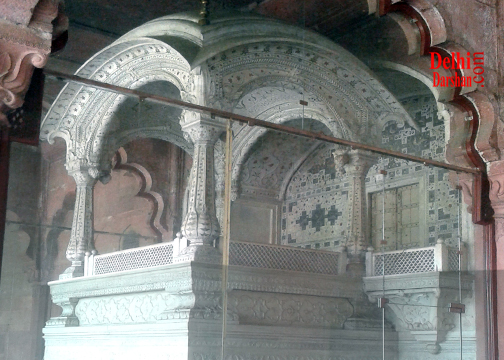In the heart of Old Delhi, a monumental structure stands as a silent witness to the grandeur and opulence of the Mughal Empire – the Red Fort. Within the majestic walls of this historical fortress lies the Diwan-i-Aam, the Hall of Audience, where the Mughal Emperor Shah Jahan once held court to listen to the grievances and concerns of the general public. As we step into the corridors of time, let’s unravel the story of this regal hall that served as a symbol of justice, power, and imperial authority. Kindly WhatsApp us, for Diwan i Aam at Red Fort Delhi.
The Red Fort
A Symbol of Mughal Splendor
Commissioned by Emperor Shah Jahan in 1638, the Red Fort, also known as Lal Qila, was designed to be the primary residence of the Mughal emperors. Its imposing red sandstone walls, intricate carvings, and sprawling layout were a manifestation of Mughal architectural brilliance. The fort served as a testament to the imperial might and cultural refinement of the Mughals, with the Diwan-i-Aam emerging as one of its central focal points.
Diwan-i-Aam
The Hall of Public Audience
At the heart of the Red Fort, the Diwan-i-Aam stands proudly, a hall where the emperor held court to address the concerns of his subjects. The very name, Diwan-i-Aam, translates to the “Hall of Public Audience,” emphasizing its purpose as a space for open dialogue between the ruler and the common people.
Architectural Marvel
Mughal Design Ingenuity
The Diwan-i-Aam is a striking example of Mughal architecture, characterized by its grand scale, intricate detailing, and a harmonious fusion of Persian, Timurid, and Indian design elements. The hall is an open pavilion with a lofty throne platform adorned with a decorative canopy, where the emperor would sit in all his regal splendor.
The façade of the Diwan-i-Aam is embellished with ornate archways and semi-octagonal columns, each intricately carved with floral patterns and inscriptions from the Quran. The use of white marble inlay adds a touch of elegance to the red sandstone, creating a visually stunning effect that is emblematic of Mughal aesthetics.
The Throne of Justice
Symbolism of the Peacock Throne
Central to the Diwan-i-Aam was the Peacock Throne – a seat of imperial grandeur that echoed the splendor of the Mughal Empire. The Peacock Throne, encrusted with precious jewels, including the famed Koh-i-Noor diamond, served as a symbol of the emperor’s authority and prosperity.
As the emperor sat on the Peacock Throne in the Diwan-i-Aam, he not only addressed the grievances of his subjects but also projected an image of divine justice. The architecture and symbolism embedded in the Diwan-i-Aam reinforced the idea of the emperor as a just and benevolent ruler, divinely appointed to govern the vast Mughal realm.
Public Address and Imperial Display
The Diwan-i-Aam was not merely a functional space for dispute resolution; it was a stage for the emperor to showcase the grandeur of the Mughal court. The open pavilion allowed for a direct interface between the emperor and the people, fostering a sense of accessibility and transparency in governance.
The emperor’s public addresses in the Diwan-i-Aam were elaborate affairs, with courtiers, nobles, and the common people assembled to witness the imperial spectacle. The resonance of the emperor’s voice, the glint of the Peacock Throne, and the architectural splendor of the hall created an atmosphere of awe and reverence. WhatsApp us, for Diwan i Aam at Red Fort Delhi.
Legacy of the Diwan-i-Aam
Echoes of Mughal Governance
The Diwan-i-Aam at the Red Fort stands as a testament to the Mughal commitment to justice, accessibility, and imperial display. Its legacy extends beyond the physical structure, echoing in the annals of Mughal governance and the collective memory of a bygone era.
While the Mughal Empire may have faded into history, the echoes of the Diwan-i-Aam linger in the cultural consciousness of India. The hall remains a symbol of a time when emperors engaged with their subjects directly, embodying the principles of fairness and accountability.
Preserving the Heritage
The Diwan-i-Aam Today
Today, the Red Fort, including the Diwan-i-Aam, is a UNESCO World Heritage Site and a testament to the rich cultural heritage of India. The Archaeological Survey of India (ASI) undertakes the responsibility of conservation and maintenance, ensuring that the Diwan-i-Aam continues to narrate its story to generations to come.
Visitors to the Red Fort can walk through the corridors of the Diwan-i-Aam, imagining the imperial court in session, the emperor on his throne, and the bustling energy of the Mughal capital. The intricate carvings, the open pavilion, and the remnants of the Peacock Throne transport visitors to an era where justice, power, and spectacle converged.
In Conclusion
Rediscovering the Diwan-i-Aam
As we stand before the imposing structure of the Diwan-i-Aam at the Red Fort, we are not just witnessing an architectural marvel; we are stepping into the pages of history. The hall encapsulates the essence of Mughal governance – a delicate balance between power and accountability, authority and accessibility.
The Diwan-i-Aam remains more than a physical space; it is a narrative woven into the cultural fabric of India. It invites us to reflect on the notions of justice and governance that transcend time and resonate with contemporary ideals. The echoes of the Diwan-i-Aam continue to reverberate, reminding us of a bygone era when an emperor, seated on a magnificent throne, sought to connect with the hearts and grievances of his people.
Important Information:
- “Manali Tour Package from Delhi“
- “Best Time to Visit Delhi“
- “Places to Visit in Delhi“
- “Delhi Agra Bus Tour“
- “Delhi Tour Packages“
- “Delhi Bus Tour“
- “Agra Darshan“
Other Options:
You may opt for Delhi VIP Tours or Delhi Darshan Cab Booking as well. You may WhatsApp us, for Diwan i Aam at Red Fort Delhi.
The above-mentioned information may change from time to time. If you find any change in details, then kindly contribute with the latest information. Delhi Darshan has created this page for general information. So, that visitors to the city can get maximum output from their trip.
This post was last modified on 25 January, 2024 5:56 pm

